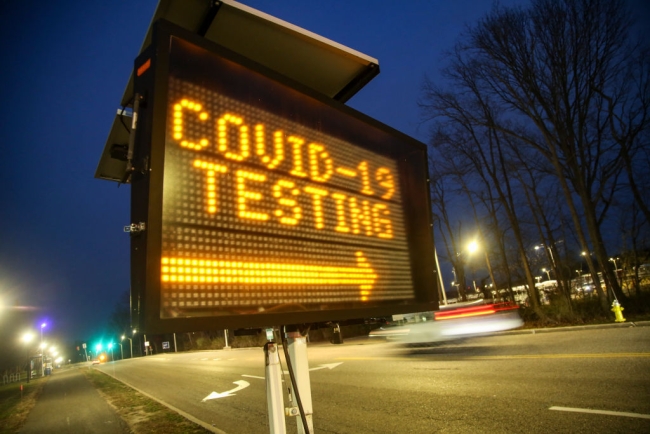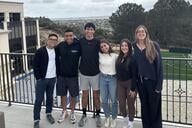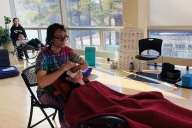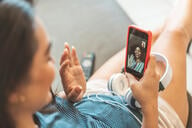You have /5 articles left.
Sign up for a free account or log in.

Newsday LLC / Contributor via Getty Images
To successfully provide on-campus instruction during the pandemic, colleges needed to prepare for several milestones. The first was bringing students back to campus safely and without increasing coronavirus case counts on campus and in surrounding towns and cities. In the following months, the primary goal was to keep case counts low.
Now, colleges face another crux as students prepare to migrate home for the Thanksgiving holiday. Some colleges altered their schedules to end in-person instruction at the Thanksgiving holiday and finish the semester online, while others will continue with in-person instruction afterward. But all face the challenge of figuring out how to navigate a holiday that revolves around travel and family gatherings when their students could be asymptomatic carriers who don't know they have the coronavirus.
In some ways, mitigating the spread of the virus will be more difficult now than it was in August. Over the past month, new case counts across the country have rocketed past previous April and July peaks, nearing 100,000 new cases daily and with few signs of slowing down anytime soon. North Dakota, South Dakota and Wisconsin emerged as new viral hot spots, as well as parts of Iowa, Minnesota, Montana and Wyoming.
Student travel has already been blamed for spreading COVID-19. Last spring, counties with more returning spring breakers had higher confirmed COVID-19 case growth rates than counties with fewer students returning from spring break, according to research put out in May by Daniel Mangrum, a research economist at the Federal Reserve Bank of New York and Paul Niekamp, an assistant professor of economics at Ball State University.
Thanksgiving travel will likely be similar, Niekamp said.
“There has always been a concern that travel by college students can spread infections from lower mortality risk students to higher mortality risk community members,” Niekamp said in an email. “Student travel around Thanksgiving is particularly concerning because there will be an exodus of students from dormitories and off-campus housing (where roommates are typically young and low-risk) to household environments where household members like parents and grandparents may be higher risk.”
Health experts are already urging people not to travel for the holidays. The Centers for Disease Control and Prevention says travel increases the risk of contracting and spreading COVID-19. It says to avoid large gatherings with people outside of one's household and suggests virtual gatherings with friends and family as a lower-risk activity.
“Your perception of safety may not match reality,” warned Anne Monroe, an epidemiologist at George Washington University, in a recent Washington Post article.
In a recent brief, the American College Health Association issued similar warnings to colleges and students. Colleges that will continue in-person instruction after Thanksgiving break should encourage students to stay on campus over the holiday, hold virtual celebrations with family and instead have a friendsgiving, according to the brief.
The University of Missouri is taking a similar approach. It plans to continue in-person instruction after the holiday and has encouraged students to stay on campus over the break. But the university does not plan to widely test students before or after the break, according to university spokesperson Christian Basi. Instead, it will continue to test symptomatic students and students with approval from a medical provider. The university’s testing policies fall in line with testing regulations for Boone County, where the university is located, Basi said.
After an outbreak at the beginning of the semester, the University of Missouri’s COVID-19 case counts have remained relatively low. As of Monday, there are 75 active cases on campus. This semester about 27,000 students are living on campus or in off-campus housing nearby, Basi said.
Colleges should maintain active testing, contact tracing and other public health measures to keep COVID-19 case counts as low as possible before the semester ends, according to the ACHA brief. Notably, the brief did not push widespread testing for all colleges.
“Testing is resource intense. It costs money and you have to have people to carry it out,” said Anita Barkin, co-chair of the American College Health Association’s COVID-19 task force. “For those schools that are well resourced, this is a great strategy. For schools that are not as well resourced, we didn’t want to suggest something that some schools could not do.”
Testing strategies this fall have been largely determined by colleges’ available resources, Barkin said. Colleges have been doing what they can to test students on campus, she said.
The ACHA brief also included advice for students who are traveling for Thanksgiving, such as to minimize stops during travel, delay travel plans if you’re feeling sick and quarantine for 14 days at home if possible.
Even if students receive a negative test before traveling, they should still practice preventative safety measures such as mask wearing and social distancing, Barkin said. If possible, students should quarantine for 14 days after traveling.
“If you were exposed during travel, or if you just hadn’t converted before you left campus to a positive, you could have a false sense of security about your status,” she said.
The State University of New York system announced recently that it will test all students using on-campus facilities prior to the Thanksgiving holiday. This includes students taking at least one class on campus; students using campus services such as the gym, dining hall and library; and students who work on campus. Exact testing schedules will vary by campus, said Holly Liapis, a university system spokesperson. Most SUNY students will finish their semester online after the break.
Testing 140,000 students is resource intensive, but not necessarily more so than the surveillance testing procedures the system already has in place, Liapis said.
The system works with the SUNY Upstate Medical University, which can administer about 200,000 tests each week. Bulk testing is cheaper for the system -- pooled surveillance testing costs about $15 per test compared with $100 to $125 per test for individual tests, Liapis said.
If students receive a positive test, they will be required to quarantine on campus over the break until they are cleared by the local public health department, she said.
“We’ve been testing regularly, and our positives are low, so our hope is that there won’t be too many that will test positive,” Liapis said. The system has space to quarantine students if necessary, she said.
Pennsylvania State University released a thorough departure plan that encourages students to get tested prior to leaving campus for Thanksgiving and finishing their studies online. Boston University has asked students to stay on campus over the holiday break. The university will hold in-person classes for the remainder of the semester, but it asked those who go home during the break to stay home and finish the semester virtually.
The Commission on Independent Colleges and Universities in New York said it is working to provide guidance to its members about the Thanksgiving holiday. CICU has been touting a low testing positivity rate for its 108 private, not-for-profit members this fall.
“Our members’ commitment to safety will continue through the Thanksgiving holiday and the end of the fall semester,” said Mary Beth Labate, CICU president, in an emailed statement. “We are working closely with state leaders and look forward to a continued partnership focused on keeping students and communities safe as students begin to leave campuses and travel home for the holidays and when they return for the spring semester.”
The U.S. Department of Education has not put together specific guidance on Thanksgiving travel but pointed to existing guidance from the CDC on college reopening.
More and more colleges have released travel guidance for students in the past couple of weeks. Still, relatively few have issued guidance at all.
Two weeks ago, very few colleges had said anything about the holiday, according to Dan Brennan, co-chief of operations at the College Crisis Initiative, called C2i, at Davidson College. More than two-thirds of colleges have no testing plan in place for the fall semester, so it’s not surprising that few have developed testing plans for Thanksgiving departure, Brennan said.
As of Monday, C2i’s understanding was that very few colleges have put out pre-Thanksgiving plans, Brennan said. But the initiative is currently collecting data to confirm this.
In a random sample of 50 institutions taken about two weeks ago, only one had a pre-Thanksgiving plan for sending students home, Chris Marsicano, assistant professor of the practice of higher education at Davidson College and founding director of the College Crisis Initiative, said during a recent American Enterprise Institute panel. He urged colleges to get a plan together as soon as possible.
“You can’t just release everybody out, you’ve got to come up with a plan,” Marsicano said during the panel. “Those institutions that have done well, that have had low case counts, that plan can be send everybody home. But for those institutions that are struggling to keep the virus at bay -- maybe you pay for testing for those two weeks before you send everyone home.”
Colleges are looking for help crafting guidance, according to ACHA’s Barkin.
“We had a high level of interest in the document we put forth,” Barkin said about the brief. “Certainly, schools are thinking about the safest way to continue after a break in the semester.”
Even with the end of the semester coming up, colleges’ instruction plans are still shifting. On Monday, the University of Arizona announced it will hold classes virtually after the Thanksgiving holiday, a change to prior plans. A spike in large gatherings over the Halloween weekend, as well as increasing COVID-19 case counts nationwide, prompted the shift.
Lebanon Valley College, a small private institution in Annville, Pa., also announced it would go fully remote at the end of this week. Few students have tested positive for the virus this semester, but more than 100 students are currently listed as self-isolating or quarantining.
“There has been an increase in the number of tests administered to campus community members and some recent positive results. There has also been an uptick in the number of students in isolation and quarantine, with growing numbers of individuals identified as close contacts,” James MacLaren, president of Lebanon Valley College, wrote in a message to students. “While there is no crystal ball to project the future, there is significant evidence that we should manage the situation before an outbreak occurs on campus.”




